|

NOTES ON THE NOVEL: ISSUE 11
Printable View
A Note on the Maps:
The maps used to illustrate this issue are reproduced
from Collins' Illustrated Atlas of London, published
in 1854. Pip's London would have been that of the 1820s, and Dickens'
London, at the time he was composing the novel, was that of 1860-1.
Collins' maps thus represent a London that falls between the historical
moment represented in the novel and the historical moment of the
novel's composition.
Since the chapters in this issue (Chs. 34-37)
take place in the mid-1820s (Meckier 179), the maps used here show
a city that has undergone about 30 years of change since Pip's time.
Nevertheless, they are very useful in tracking Pip's progress through
the city; the reader should merely keep in mind that some of the
landmarks would not have existed in the mid-'20s. The most significant
of these are the railway lines marked on the Key Map -- the
railroad did not enter London until the late 1830s and early 1840s
(Tallis's Illustrated London 186-7). The Key Map also
shows a bridge that Pip would not have recognized -- the Hungerford
Bridge between Waterloo and Westminster Bridges. And London Bridge
was, in Pip's time, Old London Bridge -- a different structure,
but built in essentially the same place. (New London Bridge would
have begun construction a few yards from Old London Bridge when
Pip was living in London, but would not have replaced the old bridge
during his tenure [Meckier 162]. Given that both London Bridges
would have been mapped in the same place, the difference between
the bridges makes no difference to our reading of the map.) Any
further discrepancies will be noted where appropriate.
History and features of Collins' Atlas
(1854)
Collins' Atlas was created in response
to the amplified tourist trade in London resulting from the Great
Exhibition of 1851. Previous to the Atlas, maps tended to
be very large and unwieldy, and though large city maps could be
folded up and carried, Collins designed his maps with a specific
view to portability (Dyos 10). The Atlas consists of one
large map of the whole city of London (the Key Map), followed
by 36 plates. The Key Map is drawn with numbered sections,
and these sections are represented in detail by the plates (the
numbers on the Key Map refer to the numbers of the plates).
The chief drawback to the Atlas is that, although the Key
Map keeps North at the top, the plates do not always observe
this convention (Dyos 13). This disregard of the compass, however
puzzling to someone attempting to navigate London in 1854, is in
many respects an advantage for the modern reader: The detailed plates
-- drawn to represent popular views of the city and/or popular routes
through it -- give us a unique view of the sites of Pip's adventures
in 19th century London. Any major discrepancies between the landmarks
shown on the maps and those that Pip would have been acquainted
with (given that the map was composed in 1854, about thirty years
after Pip's tenure in London) will be indicated where appropriate.
A Note on the Illustrations
Like Collins' Atlas, the engraved illustrations
of London reproduced in this and subsequent issue(s) were prepared
as a result of the Great Exhibition of 1851. Tallis's Illustrated
London (published in 1851-2, in two volumes) was created specifically
to commemorate the Exhibition, and furnishes, not only a great many
engravings of London scenes, but also a long history of, and commentary
on, the sights of London. Since Tallis's Illustrated London
was published, like Collins' Atlas, about 30 years after
Pip's tenure in the city, some of the views commemorated in Tallis's
would not have been available to Pip. Thus, only those illustrations
that show cityscapes and landmarks as they would have appeared to
Pip in the 1820s have been included here.
A tour of chapters 34-37
The Key Map of Collins' Atlas,
showing London as a whole, gives a useful overview of the locations
mentioned in this issue. Most of the locations referred to in Chapter
34-37 are clustered around a portion of the Thames, in -- or in
the vicinity of -- area 1 (shown in detail on Plate 1). All of the
maps reproduced here have been highlighted for convenience of reference
and increased legibility.
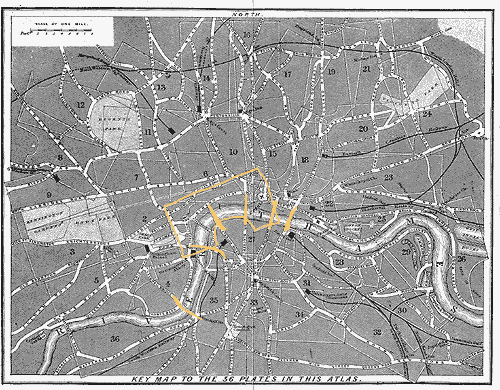
Covent Garden, where Pip and his club — the "Finches"
— dine extravagantly, is visible on Plate 1 of Collins'
Atlas (below), at the lower right side. As indicated previously,
Hungerford Bridge, which appears on this Plate, would not have existed
in Pip's time.
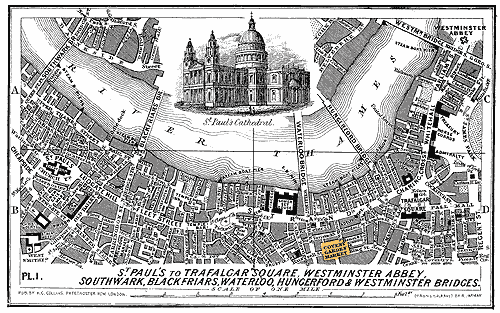
When Pip asks Wemmick's opinion about doing a monetary favor for
a friend, Wemmick -- in his professional capacity -- lists "the
names of the various bridges up as high as Chelsea Reach. Let's
see; there's London, one; Southwark, two; Blackfriars, three; Waterloo,
four; Westminster, five; Vauxhall, six" (Ch. 36). (He advises Pip
to throw his money off the side of one of them.) These bridges are
all visible on the Key Map (see Key Map again above).
Hungerford Bridge, also represented on the map, was not built until
1845, and Battersea Bridge, though built in the late 18th century,
is beyond the scope of Wemmick's reckoning.
Tallis's Illustrated London includes illustrations
of Waterloo, Westminster, and Vauxhall bridges.

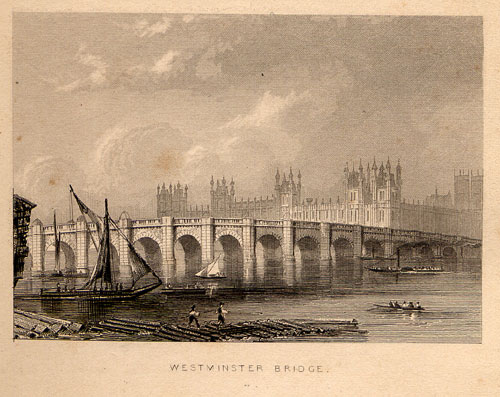
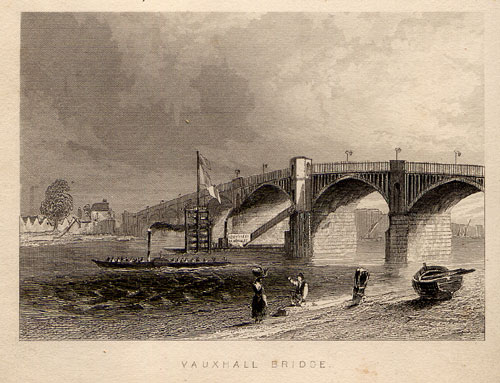
Wemmick's Aged Parent was employed in Wine-Coopering,
first in Liverpool, and then in London. The respective locations
of these two cities are shown below.
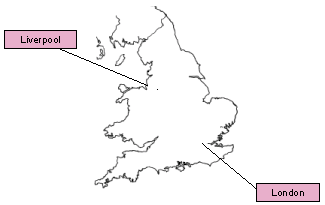
Taught the young idea how to shoot: When
Pip relates that Mrs. Pocket "taught the young idea how to shoot,
by shooting it into bed whenever it attracted her notice" (Ch. 34),
he makes a jesting allusion to James Thomson's long poem Spring
-- specifically to lines 1152-3: "Delightful task! To rear the tender
thought, / To teach the young idea how to shoot." In Mrs. Pocket's
case, of course, her rearing of the tender shoot is somewhat on
the thoughtless side, as her child is gotten out of sight and mind
with great rapidity. Spring is part of The Seasons,
which appeared between 1726-1730. The Seasons was a very
popular poem, and Thomson was influential for Romantic writers like
Wordsworth (Oxford Companion 989-90). He is also famous for
having composed the poem "Rule Britannia," which was later set to
music by Arne (see Issue
10 for a note on a reference to "Rule Britannia" in Great
Expectations).
Humanity ... brought nothing into the world
and can take nothing out, ... it fleeth like a shadow and never
continueth long in one stay: When Pip refers to these "noble
passages," he alludes to the "Order for the Burial of the Dead,"
read at funerals. The first few lines in the "Order" are taken from
specific passages in the bible (indicated in brackets): "We brought
nothing into this world, and it is certain that we can carry nothing
out [1 Timothy 6:7]. The Lord gave, and the Lord hath taken away
[Job 1:21]. Man that is born of a woman hath but a short time to
live, and is full of misery. He cometh up, and is cut down, like
a flower; he fleeth as it were a shadow, and never continueth long
in one stay" (Mitchell 500).
Funeral execution: Joe's desire to have
a simple funeral for Mrs. Joe — "'I would in preference have
carried her to the church myself, along with three or four friendly
ones wot come to it with willing harts and arms, but it were considered
wot the neighbors would look down on such and would be of opinions
as it were wanting in respect'" (Ch. 35) — is, according to
the Dictionary of Daily Wants (1858-9), perfectly respectful:
"In walking funerals it is considered a mark of respect for friends
to become pall-bearers" (450).
Girdle or cestus: Wemmick's arm, in relation
to Miss Skiffin's waist, is compared to two kinds of belts. A girdle
is a decorative belt (it was not, according to the Oxford English
Dictionary, associated with the undergarment until the 20th
century, and this meaning first came into use in America, not Britain).
A cestus has slightly more conjugal overtones, being a "belt or
girdle for the waist; particularly that worn by a bride in ancient
times" (OED, "cestus").
Iron stand hooked on to the top-bar ... a
jorum of tea: When Wemmick's Aged Parent makes "such a haystack
of buttered toast that [Pip] could scarcely see him over it as it
simmered on an iron stand hooked on to the top-bar" (Ch. 37), he
is using an early kind of toaster. The Dictionary of Daily Wants
(1858-9) illustrates this kind of toaster and gives the following
definition:
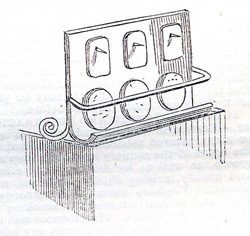
TOASTER.
-- A culinary utensil, as seen in the engraving, placed upon a
stand of strong wire, that hooks on to the bars of a grate, and
made either loose, or to slide backwards and forwards on the stand;
this will dress bread, cheese, and small pieces of meat. (1005)
A jorum is "a large drinking-bowl or vessel"
(OED, "jorum"), or the contents thereof.
Powder-mill: A powder-mill is a mill (a
factory) for making gunpowder (OED, "powder-mill") and thus,
like the Aged, prone to explosion.
Bibliographical
information
|

